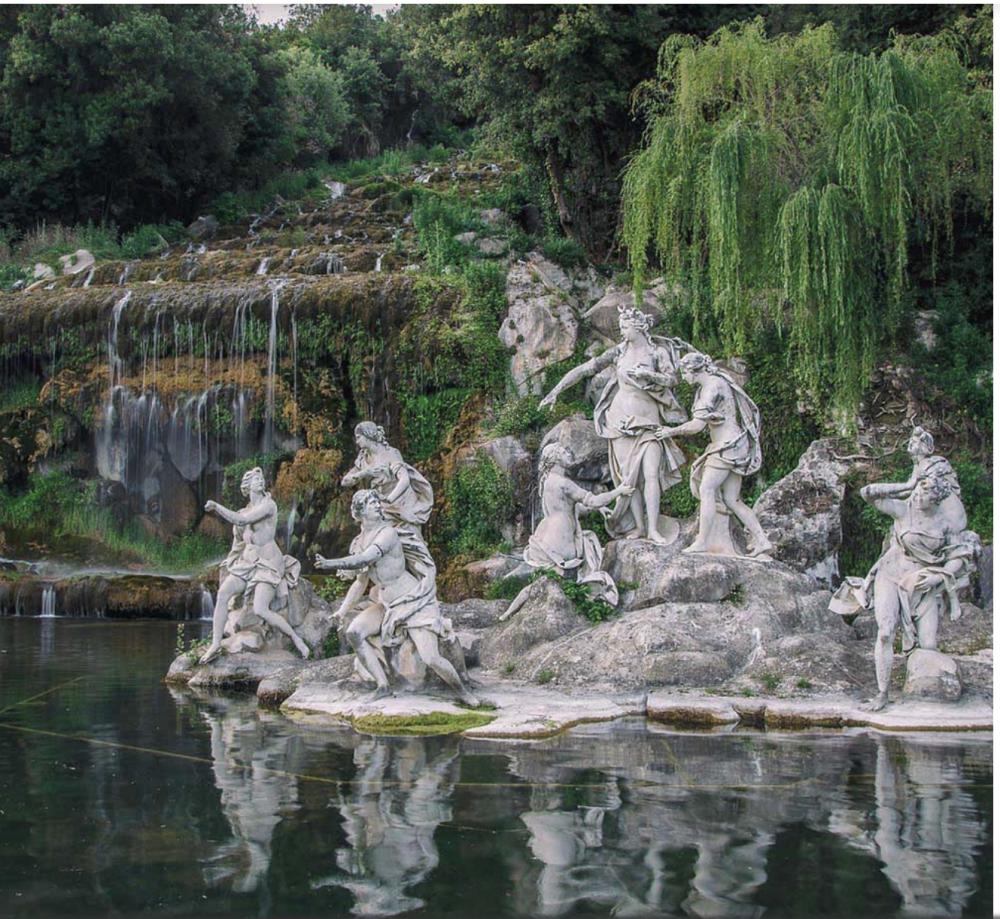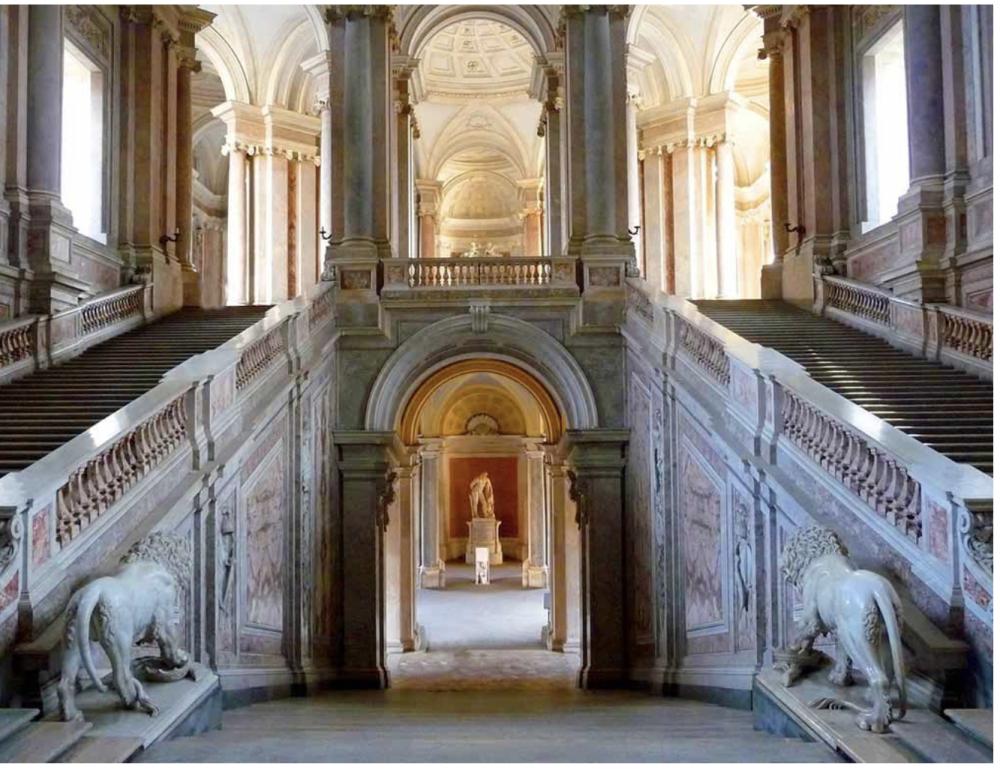Rappresenta una delle grandi espressioni del Barocco italiano, dove architettura e arte si fondono dando vita a una reggia e a un parco senza eguali. La Reggia di Caserta e il suo parco, due gioielli di ineguagliabile splendore, sono stati inseriti nella World Heritage List dell′Unesco nel 1997. Progettata nel Settecento da Luigi Vanvitelli, su incarico di Carlo III di Borbone, la Reggia, che rappresenta il trionfo del barocco italiano, è una delle opere più importanti del famoso architetto napoletano: il suo visitatore resta incantato dalla bellezza degli interni e dalle magnificenze dell′esterno. Curatissima nei dettagli ed articolata su quattro monumentali cortili, la costruzione è fronteggiata da uno scenografico parco oggi meta di migliaia di turisti. Il sontuoso palazzo è una fusione ideale e originale di altre due residenze reali: la Reggia di Versailles dei re di Francia e il madrileno Palazzo dell′Escorial, sede dei re di Spagna. La Reggia di Caserta si presenta come un vero e proprio complesso monumentale che occupa 45.000 mq e, con i suoi cinque piani, raggiunge un′altezza di 36 m. Sulla facciata principale si aprono 143 finestre e nel palazzo ci sono ben 1200 stanze e 34 scalinate. L′edificio è fabbricato in mattoni e i due piani inferiori sono rivestiti con lastre di travertino. L′intera struttura è coronata da un′ampia cupola centrale. Visitando il suo interno si è stupiti dal continuo susseguirsi di stucchi, bassorilievi, affreschi, sculture, pavimenti a intarsio. Notevoli sono quelli della Sala di Astrea, della Sala di Marte e della Sala del Trono. Quest′ultimo è il più grande degli appartamenti reali ed era adibito al ricevimento delle personalità. Le parti più scenografiche della reggia sono probabilmente l′insieme dell′atrio e del monumentale scalone d′onore e la cappella. Lo scalone è un′invenzione dell′arte scenografica settecentesca e collega il vestibolo inferiore e quello superiore, dal quale si accede agli appartamenti reali. La Cappella Palatina, progettata dal Vanvitelli fin nelle decorazioni, è di certo l′ambiente che più di ogni altro mostra una chiara analogia con il modello di Versailles. Notevole è anche il teatro di corte, mirabile esempio di architettura teatrale settecentesca: la sala a ferro di cavallo piuttosto arrotondato è resa solenne dalla disposizione particolare delle colonne, ad ordine gigante. Ma anche gli altri ambienti sono di eccezionale bellezza. La Pinacoteca al suo interno è organizzata in una serie di stanze collegate e accoglie numerosi dipinti raffiguranti nature morte, eventi bellici e ritratti della famiglia dei Borbone. Nell′appartamento vecchio è esposto il presepe borbonico, grande passione della nobile famiglia dalla quale è scaturita la nota tradizione napoletana per l′allestimento della Natività. La biblioteca palatina è annessa agli appartamenti della Regina, donna raffinata e di grande cultura, e finemente decorata da rilievi ed affreschi tra i quali quello che riproduce i segni zodiacali e le costellazioni, eseguito su disegno dello stesso Vanvitelli. Suggestive sono anche le sale dedicate alle quattro stagioni. Parte integrante della maestosità e della bellezza della Reggia è il parco, composto da fontane e cascate. Il parco è un tipico esempio di giardino all′italiana, costruito con vasti prati, aiuole squadrate e, soprattutto, un trionfo di giochi d′acqua. Lungo lasse centrale, si susseguono vasche, fontane e cascate, ornate da grandi gruppi scultorei. Ne risulta un effetto scenografico di grande impatto che raggiunge il culmine nella Grande Cascata. Il parco si estende fino alla sommità della collina antistante il palazzo, dove un giardino inglese fa da cornice ad una passeggiata tra piante esotiche. Singolare è infine il fatto che il Giardino stile inglese , meno simmetrico rispetto a quello all′italiana, fu voluto da Maria Carolina d′Austria e vi furono piantate numerose piante indigene ed esotiche, fra cui alcuni bellissimi cedri del Libano. Assieme alla Reggia di Caserta e al suo parco, l′Unesco ha inserito nella World Heritage List anche l′acquedotto , sempre realizzato dall′architetto Luigi Vanvitelli
It represents one of the great expressions of the Italian Baroque, where architecture and art come together to create a palace and a park without equal. The Royal Palace of Caserta and its park, two jewels of unparalleled splendor, were included in the Unesco World Heritage List in 1997. Designed in the eighteenth century by Luigi Vanvitelli, on behalf of Charles III of Bourbon, the Royal Palace, which represents the triumph of the Italian Baroque, is one of the most important works of the famous Neapolitan architect: its visitor is enchanted by the beauty of the interior and the magnificence of the exterior. With great attention to detail and divided into four monumental courtyards, the building is faced by a spectacular park which is now the destination of thousands of tourists. The sumptuous palace is an ideal and original fusion of two other royal residences: the Palace of Versailles of the kings of France and the Madrid-based El Escorial, seat of the kings of Spain. The Royal Palace of Caserta looks like a real monumental complex that occupies 45,000 square meters and, with its five floors, reaches a height of 36 m. On the main facade there are 143 windows and in the building there are 1200 rooms and 34 stairways. The building is made of brick and the two lower floors are covered with travertine slabs. The entire structure is crowned by a large central dome. Visiting its interior, one is amazed by the continuous succession of stuccoes, bas-reliefs, frescoes, sculptures, inlaid floors. Noteworthy are those of the Sala di Astrea, the Sala di Marte and the Sala del Trono. The latter is the largest of the royal apartments and was used for the reception of personalities. The most spectacular parts of the palace are probably the whole of the atrium and the monumental staircase of honor and the chapel. The staircase is an invention of the eighteenth-century scenographic art and connects the lower and upper vestibule, from which you enter the royal apartments. The Palatine Chapel, designed by Vanvitelli right down to the decorations, is certainly the environment that more than any other shows a clear analogy with the Versailles model. Also noteworthy is the court theater, an admirable example of eighteenth-century theatrical architecture: the rather rounded horseshoe-shaped room is made solemn by the particular arrangement of the columns, in a giant order. But the other rooms are also exceptionally beautiful. The art gallery inside is organized in a series of connected rooms and houses numerous paintings depicting still lifes, war events and portraits of the Bourbon family. In the old apartment the Bourbon nativity scene is exhibited, a great passion of the noble family from which the well-known Neapolitan tradition for the preparation of the Nativity originated. The palatine library is annexed to the apartments of the Queen, a refined woman of great culture, and finely decorated with reliefs and frescoes including the one that reproduces the zodiacal signs and constellations, executed on a design by Vanvitelli himself. The rooms dedicated to the four seasons are also suggestive. An integral part of the majesty and beauty of the Palace is the park, made up of fountains and waterfalls. The park is a typical example of an Italian garden, built with vast lawns, square flower beds and, above all, a triumph of water features. Along the central axis, pools, fountains and waterfalls follow one another, adorned with large sculptural groups. The result is a scenographic effect of great impact that reaches its peak in the Great Waterfall. The park extends up to the top of the hill in front of the building, where an English garden is the setting for a walk among exotic plants. Finally, the fact that the English style garden, less symmetrical than the Italian one, was wanted by Maria Carolina of Austria and numerous indigenous and exotic plants were planted, including some beautiful cedars of Lebanon, is singular. Together with the Royal Palace of Caserta and its park, Unesco has also included the aqueduct in the World Heritage List, also built by the architect Luigi Vanvitelli





























